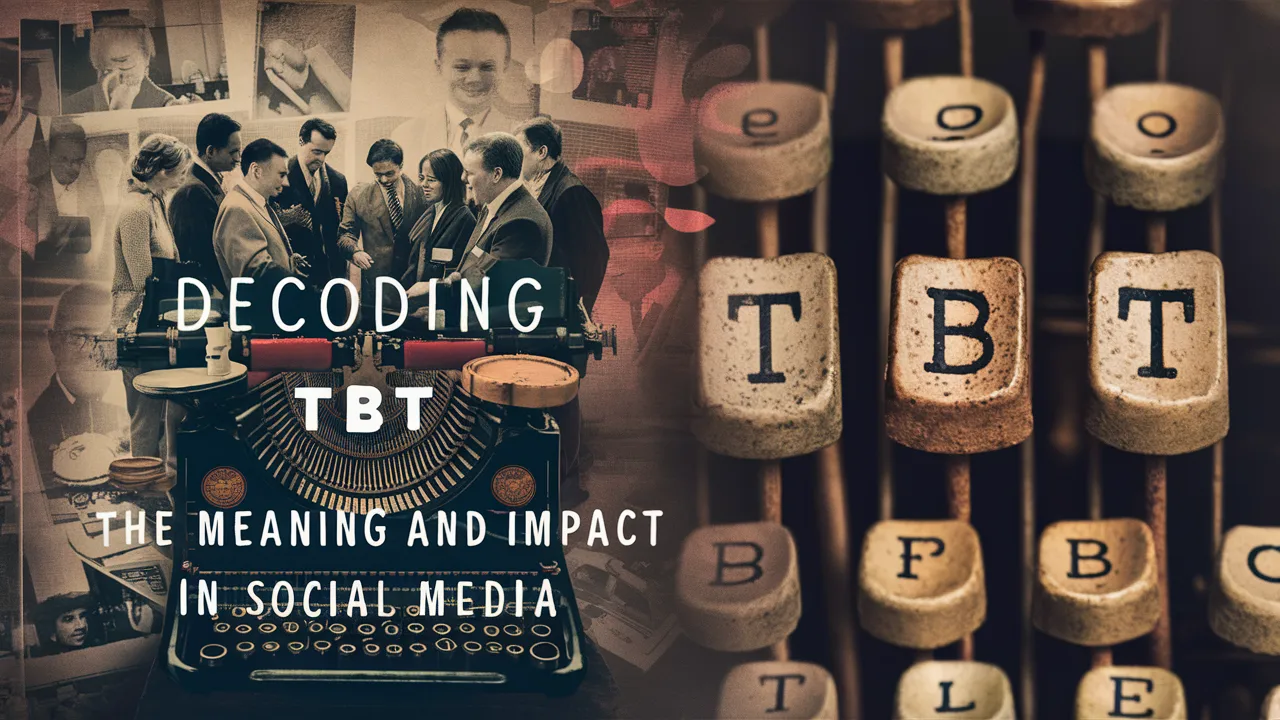In the vast landscape of social media, where trends emerge and evolve at a rapid pace, one phenomenon has stood the test of time – Throwback Thursday, affectionately known as TBT. Stemming from a collective desire to reminisce and share cherished memories, TBT has established itself as a cultural touchstone in the realm of digital communication.
Defined by users posting nostalgic content harking back to days gone by, this weekly tradition evokes a sense of nostalgia and fosters connectivity through shared experiences.
The origins of TBT can be traced back to the early days of social media platforms like Instagram and Facebook, where users first began repurposing old photos and anecdotes for thematic posts on Thursdays.
Over time, this simple act evolved into a widespread practice embraced not only by individuals but also by brands seeking to engage with their audience on a more personal level.
As TBT grew in popularity, its impact transcended mere moments of reflection; it became a strategic tool for storytelling, cultivating sentimentality, and fostering authentic connections in the digital sphere.
Understanding TBT in Social Media.
Throwback Thursday (TBT) posts hold significant value in the realm of social media by serving as potent tools for fostering engagement and evoking nostalgic sentiments among users. These posts create a window into the past, allowing individuals to revisit cherished memories and reflect on moments gone by.
For followers, engaging with TBT content often elicits emotional responses tied to personal experiences, strengthening their connection to both the poster and the platform itself.
Brands have adeptly leveraged TBT as a vehicle for storytelling, utilizing nostalgia as a powerful tool to connect with their audience on an emotional level. Through carefully curated throwback content, companies can invoke sentimentality that resonates with their target demographic, establishing a more profound bond beyond mere product promotion.
By tapping into shared cultural touchstones or historical references within their TBT campaigns, brands can tap into collective memories that forge lasting connections with consumers.
Numerous renowned companies and influencers have successfully harnessed the potential of TBT campaigns to engage their audiences effectively.
For example, Coca-Cola’s #TBT campaign artfully combined nostalgic branding elements from its archives with modern marketing techniques to create captivating digital content that sparked user engagement and solidified brand loyalty.
Similarly, influencers such as travel bloggers who use TBT posts to share personal stories or travel adventures often strike a chord with followers seeking escapism or relatable experiences.
These examples underscore how adept use of TBT can not only enhance engagement but also strengthen relationships between brands/influencers and their respective audiences.
Analyzing the Impact of TBT.
Throwback Thursday (TBT) posts have a notable psychological impact on social media users by evoking strong emotional responses and triggering memories associated with past experiences.
By sharing throwback content, individuals often experience nostalgia, a sentimental longing for moments gone by, which can lead to heightened feelings of happiness and connectedness.
This emotional resonance plays a crucial role in engaging audiences and fostering a sense of community among followers. Brands that effectively tap into these emotions can establish deeper connections with their audience, leveraging the power of nostalgia to create positive associations with their products or services.
In addition to influencing individual emotions, TBT contributes significantly to building brand loyalty and strengthening customer relationships. When brands share nostalgic content that resonates with their audience, they demonstrate an understanding of their followers’ preferences and values.
This personalized approach enhances trust and loyalty among customers, as they feel seen and valued by the brand. By consistently incorporating TBT posts into their content strategy, brands can nurture long-term relationships with their audience based on shared memories and experiences.
Different types of TBT posts—such as photos, videos, or captions—vary in their effectiveness in driving user interaction on social media platforms. While visual content like photos and videos tend to be more engaging due to their ability to evoke vivid memories and emotions, well-crafted captions can also capture attention and spark conversations.
Understanding the preferences of your target audience is essential when selecting the type of TBT content to share. By analyzing metrics such as likes, comments, shares, and click-through rates associated with different post formats, social media managers can optimize their strategies to maximize user engagement and foster community interaction through compelling throwback narratives.
In summary, the impact of TBT goes beyond mere nostalgia; it extends to shaping emotional connections between users and brands while enhancing user engagement across various social media platforms.
By strategically harnessing the psychological effects of throwback content through engaging storytelling methods and personalized approaches tailored to their target audience’s preferences, brands can leverage the enduring appeal of nostalgia to create meaningful interactions that resonate with followers on a deep emotional level.
Best Practices for Utilizing TBT.
To effectively leverage Throwback Thursday (TBT) in social media strategies, social media managers should consider several key practices. Firstly, incorporating TBT into content calendars should be done thoughtfully and strategically.
It is essential to align TBT posts with the overall content strategy while keeping in mind the audience’s preferences and engagement patterns. By integrating TBT posts consistently and purposefully, brands can maintain a balance between nostalgia and relevance in their social media presence.
Selecting the right throwback content is crucial for maximizing audience engagement. When choosing TBT material, social media managers should prioritize posts that evoke positive emotions, resonate with followers’ memories, and align with the brand image or message.
For example, sharing behind-the-scenes photos from a company’s early days or revisiting iconic ad campaigns can create a sense of authenticity and connection with the audience. By selecting compelling throwback content, brands can strengthen brand loyalty and enhance their storytelling capabilities.
Regarding scheduling considerations and frequency guidelines, it is recommended to strike a balance between consistency and variety when posting TBT content. Social media managers should establish a cadence that suits their target audience’s preferences without overwhelming them with too many throwback posts.
For instance, alternating between different types of TBT content formats (such as photos, videos, or quotes) and mixing in current content can help maintain interest and keep followers engaged over time. By analyzing engagement metrics related to timing and frequency of TBT posts, brands can refine their posting schedules for optimal results.
Measuring Success with TBT Campaigns.
Key performance indicators (KPIs) play a crucial role in assessing the effectiveness of Throwback Thursday (TBT) initiatives on social media. Engagement metrics, such as likes, shares, comments, and reach, serve as primary KPIs for evaluating TBT campaigns.
By tracking these metrics, social media managers can gauge the level of audience interaction with throwback content. For instance, a high number of comments on a TBT post could indicate significant engagement and interest from followers.
Additionally, measuring the click-through rate (CTR) on links shared within TBT posts can provide insights into how successful the campaign is in driving traffic to specific pages or websites.
Analytic tools offer valuable capabilities for monitoring and analyzing engagement metrics related to TBT posts. Platforms like Hootsuite, Sprout Social, and Google Analytics allow users to track various performance indicators accurately.
These tools provide detailed reports on reach, impressions, user demographics, and engagement rates associated with TBT content. By leveraging these analytics, social media professionals can gain a deeper understanding of their audience’s preferences and behaviors when it comes to consuming throwback content.
Interpreting data from TBT campaigns is essential for optimizing future strategies and enhancing overall performance. By examining trends in engagement over time periods or across different types of TBT posts (photos vs. videos), marketers can identify patterns that inform content creation decisions.
For example, if video-based TBT posts consistently yield higher levels of engagement than static images, it may be beneficial to prioritize video content in future campaigns. Moreover, analyzing which nostalgic themes resonate most with the audience can guide the selection of throwback content that generates maximum impact and interaction.
In conclusion, by establishing relevant KPIs, utilizing analytic tools effectively, and interpreting data strategically, social media professionals can measure the success of their TBT campaigns accurately.
This data-driven approach enables marketers to refine their strategies based on real-time feedback and audience insights gathered from previous initiatives.
By continuously optimizing TBT content based on performance metrics and industry trends, brands can maximize their impact on social media platforms and strengthen connections with their online communities through engaging throwback experiences.
Ethical Considerations in Using TBT.
When sharing personal throwback moments on social media, individuals should be wary of potential privacy concerns. While Throwback Thursday posts are often seen as innocent and nostalgic, they can inadvertently reveal sensitive information about oneself or others.
It’s important to consider the implications of sharing personal history publicly, especially if it includes details that could compromise privacy or security. For example, posting a throwback picture of a childhood moment may unintentionally disclose personal information like your former address, school name, or family members without considering their consent.
For brands engaging in TBT campaigns, ethical considerations become paramount when utilizing historical images or references. Companies must ensure that the content they share aligns with ethical standards and does not exploit sensitive events or people for marketing purposes.
Using historical images thoughtfully and with respect for the context in which they were created is crucial to avoid offending audiences or misrepresenting historical narratives. For instance, a fashion brand referencing iconic cultural moments in a TBT campaign should do so tastefully and without trivializing significant events.
Respecting copyrights and permissions is essential when reposting third-party throwback content. Brands and individuals alike must obtain proper authorization or use content under fair use guidelines to avoid copyright infringement issues.
Acknowledging the original source of the throwback content is not only an ethical practice but also demonstrates respect for intellectual property rights.
For instance, if a brand shares a user-generated throwback photo as part of a campaign, obtaining permission from the creator and crediting them appropriately can help maintain trust with followers and uphold ethical standards in content sharing practices on social media platforms.
Conclusion.
In deciphering the essence of Throwback Thursday (TBT) in the realm of social media, it becomes evident that this recurring trend serves as a potent tool for users, brands, and influencers alike to forge meaningful connections with their audiences through nostalgia-driven narratives.
Delving into the dynamics of TBT campaigns reveals not only their ability to evoke emotions and memories but also their potential in bolstering brand loyalty and improving customer relationships.
By embracing TBT strategically, content creators can tap into the reservoirs of sentimentality that lie within their followers, translating into heightened engagement and resonance.
As digital landscapes continue to evolve, understanding the nuanced impact of TBT unveils a spectrum of opportunities for social media professionals and marketers to craft compelling narratives that transcend mere posts into experiential journeys.
From navigating ethical considerations surrounding privacy and copyright to harnessing analytical tools for measuring campaign success, the strategic utilization of TBT emerges as a powerful instrument in leveraging the emotional currency permeating modern social interactions.
By aligning content strategies with the inherent pull of nostalgia, practitioners can sculpt authentic narratives that resonate deeply within virtual communities, fostering enduring connections amidst the ever-shifting tides of social media engagement.




